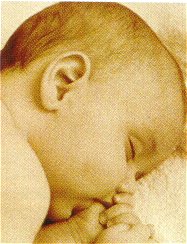| Chapter 11: | The Infant | |
| Page 4 0f 11 |
Cardiac and Pulmonary Diseases in the Infant
RCPs need to be alert to the clinical signs of cardiac and pulmonary diseases in infants, including:
- Tachypnea (respiratory rate above 60)
- Wheezing (can indicate edema in small airways)
- Retractions (can indicate increased WOB)
- Rales (indicate fluid in small airways)
- Grunting (can increase the FRC)
- Nasal flaring (sign of respiratory distress)
Meconium Aspiration
Meconium is present in the amniotic fluid of nearly 10% of all infants at birth, and of those, between 20-25% go on to suffer some form of significant pulmonary disorder. Pneumothorax is frequently a complication of meconium aspiration, whose clinical indications include: tachypnea, rasping or faint respirations, patchy infiltrates on x-rays, hyperinflation, and severe cyanosis.
Aggressive suctioning is called for to eliminate airway obstructions, and placement of a nasogastric is needed to vacate swallowed meconium and stomach contents. Treatment for metabolic acidosis if required, and supplemental oxygen with mechanical ventilation may be needed in order to maintain the infant's ABGs. Oxygen consumption and carbon dioxide production can be kept to a minimum through thermoregulation.
 |
Pneumothorax
Tension pneumothorax can present as a complication of meconium aspiration, ventilation with positive pressure, pneumonia, hyaline membrane disease, pneumonia, and diaphragmatic hernia. Any newborn in respiratory distress should be reviewed for the presence of pneumothorax. Since pneumothorax can be seen in nearly 1% of all normal deliveries, even asymptomatic infants require observation of vital signs.
Clinical signs include onset of respiratory agitation or distress, tachypnea, nasal flaring and grunting, cyanosis, and the apical pulse's movement away from the site of the pneumothorax. The most effective differential diagnosis can be made from radiographs. Severe distress may require insertion of a closed system chest tube with continuous suction. The rate of absorption can be enhanced with pure oxygen, but retrolental fibroplasia is a risk.
Pneumonia
Enteric organisms such as E. coli and group B streptococcus are the most causative organisms of perinatal infections. Postnatal pneumonia is most often caused by contamination of the neonate's airway by infected humidifier reservoirs, poor hand washing, and contaminated equipment. Nonbacterial organisms that can cause pneumonia are acquired by contact with an infected birth canal or nosomial infection.
The diagnosis of neonatal pneumonia is clearly an inexact science. It is generally based on the history, physical examination, chest x-ray results, and lab data. Symptoms of pneumonia in a neonate, which often present within 48 hours of delivery, include tachycardia, signs of respiratory distress, flaccidity, pale skin, cyanosis, with foul smelling amniotic fluid indicating the presence of infection.
Other clinical signs may include an inconsistent WBC (either depressed below 5,000 or elevated above 15,000), elevated temperature, and/or x-rays showing unilateral or bilateral streaky densities in the perihilar region. Signs of a pneumonia acquired postdelivery can include an increasing tachycardia, poor feeding, lethargy, and aspiration of feedings.
Treatment of neonate pneumonia includes aggressive pulmonary suctioning, thermoregulation, fluid and electrolyte control, supplemental oxygen therapy, identification of the pathogen, and treatment with broad-spectrum antibiotics. Clinical symptoms need to be treated as they appear, with blood gas values closely monitored and treated.